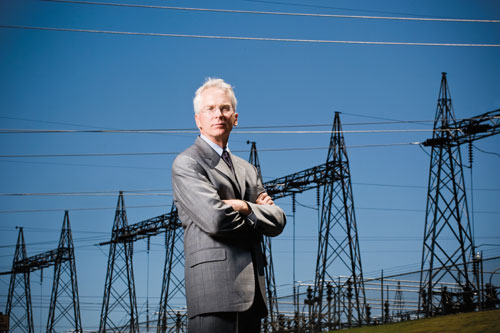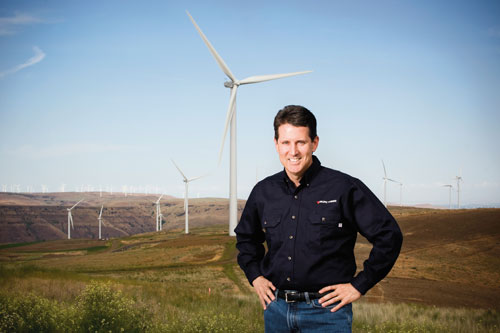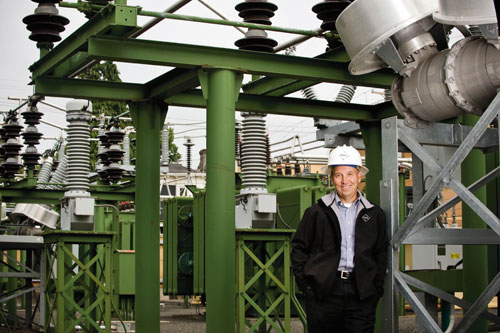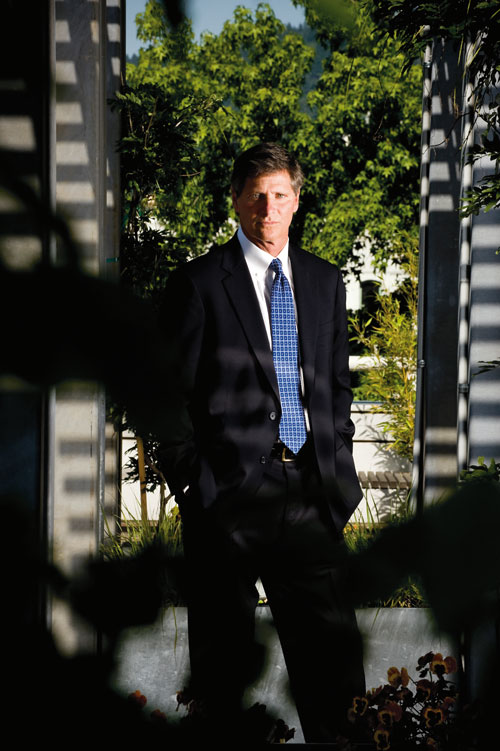 The chiefs of BPA, Northwest Natural, PGE and Pacific Power can’t see the energy future, but they know one thing: Change is coming and it won’t be simple.
The chiefs of BPA, Northwest Natural, PGE and Pacific Power can’t see the energy future, but they know one thing: Change is coming and it won’t be simple.
The chiefs of BPA, Northwest Natural, PGE and Pacific Power can’t see the energy future, but they know one thing: Change is coming and it won’t be simple.
STORIES BY BEN JACKLET
PHOTOS BY LEAH NASH
Jim Piro, the new CEO of Portland General Electric and a 35-year veteran of the utilities industry, recalls a time not long ago when electricity rarely made headlines.
“We’d go months without being in the newspaper,” he says.
Not any more. Utility executives are no longer the dependable if somewhat predictable suppliers of the literal power that runs the economy, reliably running regulated monopolies that most people take for granted and blissfully ignore. Environmental concerns are growing. Emission caps are coming. Momentum for a radical shift toward a new economy, cleaner and greener than the current one, is building. The future of power generation isn’t just a part of the debate over what comes next. It is at the core of the matter.
No one in Oregon is more acutely aware of the energy challenges ahead than Jim Piro, Pacific Power President Pat Reiten, Bonneville Power Administration CEO Stephen Wright and Northwest Natural CEO Gregg Kantor. These four men (they’re all men again after the recent retirements of Peggy Fowler and Judi Johansen) are seasoned utility executives who are quick to praise the grid as it is. But they know change is coming, possibly radical change.
The shift has already started with wind power. BPA, PacifiCorp and PGE all claim to be leading the nation in wind, and they are all correct. BPA leads the way in incorporating wind into its transmission lines. PacifiCorp, in partnership with its parent company, is far and away the largest investor in wind among the nation’s utilities. PGE is No. 1 in convincing homeowners to pay a premium for clean power.
But for all of their breezy gains, they aren’t even close to where they need to be by 2025. Barring substantial changes in Oregon law, many more windmills will need to be built, and wind is proving even less reliable a power source than expected. Which brings us to natural gas. Each of these executives — even Wright, whose company burns no fossil fuels — agrees the best way to back up the intermittency of wind is with natural gas plants, which rev up quickly and emit half the carbon of coal plants. That’s the trend behind Kantor’s determined quest to bring a liquified natural gas (LNG) terminal and a new pipeline to Oregon, to keep prices from rising out of control as the “race to gas” takes off.
The LNG plan has been roundly criticized by environmental groups and elected officials, but Kantor, who launched his career as a staffer for ex-Gov. Neil Goldschmidt, knows how to sell a deal. A big mentor of Kantor’s was Richard Reiten, who served as president of PGE and CEO of Northwest Natural — and also happens to be Pat Reiten’s father. Kantor’s daughter and Pat Reiten’s son are close friends and schoolmates.
Oregon’s top energy executives know each other well. They have much in common, most significantly an appreciation that the coming transition into a new era for energy will be neither simple nor dull.
The control freak
 |
EXECUTIVE: Stephen Wright, administrator, CEO |
Stephen Wright’s tenure as top administrator and CEO of Bonneville Power Administration has been marked by one monumental challenge after another: a tumultuous power crisis brought on by California’s deregulation debacle, new long-term contracts with the 135 power fiefdoms that are the agency’s preferred customers, a huge deal with Native American tribes regarding salmon, and the most expensive fish and wildlife restoration project in the nation.
That’s nothing compared to what lies ahead for the federal agency that supplies 40% of the power used in the Pacific Northwest from 31 dams and a nuclear power plant. Given the inherently intense position Wright occupies and the constant contortions he must undergo in the name of balance, it’s not surprising that he sounds a bit hesitant as he addresses questions that are not easily answered. BPA’s original mission of cranking out and transmitting massive volumes of cheap, reliable power seems almost quaint amid the intensifying push for new sources of renewable electricity and the increasingly vocal support for (and recent examples of) dam removal. When Wright discusses the radical changes ahead, the word he returns to frequently as a sort of unresolved refrain is “scary.”
Bonneville Power AdministrationEstablished: 1937, Portland Source: BPA |
One major source of Wright’s apprehension is wind, which is proving more problematic than BPA’s engineers had expected. Here’s how he explains the situation:
“If you get on an airplane and fly out of Portland today going east and you look out the window, you’ll see a thousand match sticks that weren’t there before, sticking up with turbine blades on them. That is almost all within Bonneville’s balancing authority. At the end of the day, the transmission operator is responsible for making sure that loads and resources are in balance every second of every day. And we have very little ability to store electricity. So when the wind is going up or down we have to make sure that other generation goes up or down to balance it. It has been amazing to find that the ramp rates on these facilities are substantial, much more so than we’ve ever had to deal with before. Think how culturally hard this is, because we in the utility industry are control freaks. We have to be. And now you throw in this resource that’s going up and down all the time, in random patterns that we have not been able to draw statistical correlations with, and we’re trying to make that work. It’s scary.
“It’s also fun. Things can be scary and fun at the same time. Roller coasters are great.”
So long as they don’t derail. Wright’s latest intelligence indicates that BPA is frighteningly close to reaching its wind limit. The agency has about 2,000 megawatts in the system and “we think somewhere between 3,000 and 3,500 is the straw that breaks the camel’s back.”
The thing is, plans are under way to boost BPA’s wind load to 6,000 megawatts over the next few years, to meet the demand for new sources of renewable power. That would break the camel’s back twice. “It’s an unsolvable problem with the current system we have in place,” says Wright.
Clearly Wright is a big fan of the current system, which has cranked out reliable, inexpensive hydropower with no carbon emissions since BPA was founded in Portland in 1937. Recent agreements to restore salmon habitat by removing dams in the Klamath Basin and elsewhere have not convinced him even remotely to reconsider dams within the federal system. As a loyal 28-year employee of the agency, Wright reserves much of his enthusiasm for applauding the hydro system, which he praises as “fabulously efficient.”
But thousands of new wind turbines and steady scrutiny from fish advocates mean the system that has worked so efficiently for so long will have to change, substantially. That’s no small task for a government agency employing nearly 3,000 people.
Part of the solution may come from smart-grid technology. BPA was an early leader in smart-grid research and has collaborated with Pacific Northwest National Laboratory in Richland, Wash., to develop the technology that enables utilities to communicate instantaneously with end users and modify electricity use to maximize efficiency.
“This is the first big experiment any place in the world to try to figure these things out,” Wright says. “It’s a big change in our mindset and how we operate systems, and everybody’s a little nervous about this because we’ve done it one way and it works, and now we’re talking about a radical change. But can it work? Yeah.”
It will have to. Wright’s new boss is Energy Secretary Steven Chu, a Nobel Prize-winning physicist on a mission to transform the nation’s electricity system into a new era. Leaders resistant to radical change will not last long under Chu’s watch. Asked about his future at the BPA, Wright says: “I serve at the pleasure of the secretary. If he wants somebody new, he’ll let me know and I’ll move on.”
The insider
 |
EXECUTIVE: R. Patrick Reiten, President |
The last time Pat Reiten made a presentation to Warren Buffett, it involved a $6.1 billion investment that required board approval. He had just 10 days to prepare, right around the July 4th holiday.
“I wasn’t a lot of fun for the family over that holiday,” Reiten recalls. “But for that meeting, or any MidAmerican meeting, you don’t want to say, ‘I don’t know, I’ll have to get back to you.’ Or even worse, ‘I never thought of that.’”
Reiten launched his career as an aide to Sen. Mark Hatfield. His father Richard Reiten ran Oregon’s economic development department before serving as president of PGE and CEO of Northwest Natural. The junior Reiten, 47, has deep roots in the Oregon business community, a warm, personable style and lively sense of humor. He joined the Buffett team in September 2006, not long after Berkshire Hathaway’s MidAmerican Energy Holdings Co. bought PacifiCorp from Scottish Power for $5.1 billion. As president of 1,261-employee Pacific Power, one of three business platforms within the restructured PacifiCorp, Reiten reports to PacifiCorp CEO Greg Abel, MidAmerican CEO David Sokol (one of the heirs apparent of the Buffett empire) and Buffett himself. And it doesn’t take long to figure out that he is thrilled to be a part of that chain of command.
“The reason that MidAmerican has been successful and the reason that PacifiCorp has been and will be successful is that we try to do the simple things well,” he says. “Make investments that make sense. Run your business efficiently. Keep your costs down. Deal with regulators and legislators and governors with integrity. Do what you say, say what you mean. It’s a very straightforward, Midwestern ethic, but I think it works very well here in the Northwest, too.”
Pacific PowerOne of three businesses under the restructured PacifiCorp; purchased by Berkshire Hathaway in 2006 2008 revenues: $1.3 billion Sources: PacifiCorp, Business Week |
That may be. But for all of the emphasis Buffett and his loyalists put on keeping things simple, they face extremely complex times in the energy industry. By far the most important source of electricity for MidAmerican, PacifCorp and Pacific Power is coal, the largest producer of greenhouse gases in the world. Replacing coal with renewable sources of energy to meet Oregon’s renewable portfolio standards and prepare for national carbon caps is a costly proposition.
The first step PacifiCorp has taken to achieve a cleaner portfolio has been to invest $2 billion in wind power over three years. “When I walked in the door in September of ’06, we owned 32.5 megawatts of wind,” says Reiten. “Today we own approximately 800 megawatts of wind. By the end of the year we will have 1,340 megawatts either owned or purchased. That’s a substantial investment.”
According to the American Wind Energy Association, PacifiCorp and MidAmerican own more wind power than any other utility in the nation. But at less than 5% wind, PacifiCorp will have to do much more to meet Oregon’s requirement that utilities generate 25% of their electricity from renewable sources by 2025.
Adding to the challenge is a headline-generating development within Pacific Power’s service area that will result in a loss of power rather than a gain. After coming out strongly against the removal of four PacifiCorp dams in the Klamath River Basin a year ago, Reiten has reversed his position and signed an agreement with regulators that will eventually remove 169 megawatts of carbon-free hydro power from PacifiCorp’s portfolio. Here is how he explains the reversal: “We viewed this not as a political matter but as a business proposition for our company. The keys for us were limiting our exposure to dam removal costs and absolving our customers of the liability involved.”
In a time when dams are more likely to be torn down than built, PacifiCorp’s strategy is to continue investing in wind power, supplemented by gas plants and 2,000 miles of new transmission lines. The transmission lines (the $6.1 billion project Reiten presented to Buffett and his board last July) would extend from PacifiCorp’s wind farms in Wyoming into Utah, Idaho and Oregon.
To help fund these developments PacifiCorp is asking state utility regulators for a 9.1% rate increase. Reiten allows that it is a difficult time to raise rates with the recession spreading and unemployment rising, but he argues, “We haven’t had a rate case in Oregon since 2006, and we have been and will remain one of the lowest-cost utilities in the country.”
Reiten plans to minimize costs through efficiencies inherent to all companies under the Berkshire Hathaway umbrella. “There are some real advantages to having this holding company in terms of access to expertise, access to great management and access to low- cost capital.”
Another company Buffett recently invested in is BYD, the Chinese battery giant that has released an electric vehicle with a range of 250 miles. Reiten met with BYD executives while in China with Gov. Ted Kulongoski on a trade mission, and those discussions have led to a compelling new collaboration Reiten calls “potentially a game-changer,” with super-efficient batteries storing the extra electricity while the wind is humming or the sun is beating down, to transmit it through the system at a later time when it is needed.
“BYD is the No. 1 cell phone battery manufacturing company in the world,” says Reiten. “They have staked their company on being the best in terms of batteries and we think there are utility applications.”
The partnership could develop into something exciting. Then again, it could flop. Either way, there will be no quick fix to the challenges Reiten and PacifiCorp face. As he lays out his strategy Reiten has a lot to say about a lot of things, but he doesn’t say much about coal, which is PacifiCorp’s greatest asset and its greatest liability.
Pressed on the subject, Reiten nods and says: “Sure, we’ll probably see coal plants phased out over time. And the new investments will be higher cost. The key will be making the transition at a pace that makes sense for our customers and doesn’t put the businesses and the states we serve at a competitive disadvantage.”
The spark plug
 |
EXECUTIVE: CEO Jim Piro |
Keeping up with the new CEO of Portland General Electric takes energy.
Tightly wired, ebullient and humming with his own internal electricity, Jim Piro is both blunt and thoughtful as he races through the list of challenges that he faces running Oregon’s largest utility during a time of looming uncertainties. Whether the subject is the undecided future of the Boardman coal plant, the troubled past of the Trojan nuclear plant, or the futuristic potential of smart-grid technologies and electric vehicles, Piro tackles each new subject with candor and enthusiasm, rarely if ever seeming to censor himself.
It’s not uncommon for him to shrug and say, “We don’t know the answers to any of those questions,” or “Whether that’s good news or bad news, it’s the truth.” Late in the interview, he jokes that sometimes the company’s corporate communications staff wishes he would be more cautious about what he says and doesn’t say, but by then it is too late to take anything back.
Portland General ElectricEstablished: 1889, Portland Sources: PGE, DEQ, Business Week |
Unlike other top executives in Oregon’s energy sector, Piro is neither a political appointee nor a longtime political insider. He is a technocrat, a former Oregon State University engineer with 35 years in the electricity business. He joined PGE in 1980 as a civil engineer, developed his financial acumen working on rate cases, and served as CFO from November 2000 through the end of 2008 before taking over for former CEO Peggy Fowler this year.
Fowler’s tenure was complicated by the implosion of former PGE owner Enron and takeover attempts by the private equity group TPG and the City of Portland. Since going public in April 2006, PGE has reasserted its viability as an independent, vertically integrated electric utility. Its stock, however, has not performed well, losing a third of its value over the past three years.
The biggest immediate change Piro inherits involves wind power. PGE is investing a billion dollars in the 450-megawatt Biglow Canyon Wind Farm in the Columbia River Gorge. But wind accounts for just 4% of PGE’s current power mix. Wind’s share is expected to grow to 11% by 2012, but those electrons mostly would replace power generated by hydro dams, not coal or gas plants, meaning pollution gains would be modest. Furthermore, growing PGE’s renewable portfolio to 25% by 2025 as required by Oregon law will be an engineering challenge as well as a fiscal one, because wind is proving even less predictable as a source of energy than was originally expected. Too much wind is proving even more problematic for utility engineers than not enough of it.
That means PGE will need to back up its wind investments with something reliable and easily cranked up, i.e., natural gas power plants. That means more emissions, because while gas plants pollute less than coal plants, they still pollute.
“We’re not going to go back to being a Third World country and say, ‘Guess what? The wind’s not blowing so we’re not going to have any electricity today,’” says Piro. “At the end of the day, if we’re going to replace coal, we’re going to need new molecules.”
That’s a big if, and it raises a complex issue for PGE. PGE owns and operates the Boardman coal plant, which is by far the largest source of greenhouse gases in Oregon. PGE also holds a 20% interest in the Colstrip coal plant in Montana. Both plants are low-cost power producers, as well as increasingly risky environmental liabilities. After years of scrutiny, the Oregon Department of Environmental Quality has required major investments at Boardman, with strict deadlines.
“The company has two choices,” says Piro. “Run the plant through 2014 and shut it down, or spend $700 million, implement all those measures, and run the plant basically forever. This is not an easy analysis. If we shut down Boardman we’ll have to replace it with natural gas. That’s the only really viable resource. The questions are: What are gas prices going to be? What are coal prices going to be? And the biggest uncertainty is how much is carbon going to cost? We don’t know the answer to any of those questions.”
There are only two coal power plants in Oregon and Washington, and environmental groups are considering a campaign to shut down both of them. Piro is a veteran of PGE’s controversial foray into nuclear power (which he considers a mistake in retrospect), so he is familiar with the political implications of operating unpopular plants. Still, he says, “We have a responsibility to be prudent about fuel diversification, so we have to think seriously about what shutting down Boardman would mean for our dependence on natural gas and the availability of gas or lack thereof. There’s only a limited supply of natural gas, and we would have to study the supply side very carefully.”
So does he support the proposal to build a liquefied natural gas terminal near Astoria? Piro shakes his head and says he “wouldn’t want to burn any bridges” by backing LNG.
Clearly, Piro is more comfortable discussing technology than taking political stands. His enthusiasm returns once the conversation turns to smart-grid technology and electric vehicles. PGE is spending $130 million to install 850,000 smart meters by 2010, allowing two-way communication between the utility and residential and commercial customers. The utility is also working to recruit electric car companies such as Think, Nissan and Mitsubishi to Oregon.
The efforts to encourage electric cars and build a smarter grid are connected because a smart grid would grant the utility some control over when and how electric cars and other appliances are charged and used, to maximize efficiency.
“Eventually as we put our smart meters out there and create a smart grid with smart appliances, we’ll be able to do some load control when the wind stops blowing, to manage the uncertainty,” Piro says. “And when the wind is really blowing, you can add load by doing things like charging your electric vehicles at night. Over time, appliances will have these smart chips installed, as will electric vehicles. And technology will improve for communicating with those devices. That’s where the smart grid’s ultimately going. It just makes sense from an efficiency standpoint.”
If only all of the industry’s uncertainties could be so smartly resolved.
The natural
 |
EXECUTIVE: CEO Gregg Kantor |
Gregg Kantor is a born communicator. He served as communications director under Gov. Neil Goldschmidt in the 1980s, held public affairs positions with BPA, PGE and Northwest Natural during the 1990s, and gradually worked his way up the ranks at NW Natural on the strength of his ability to persuade.
Since taking over as CEO in January, Kantor has kept his message consistent and clear. In his view, it is time to increase Oregon’s gas supply by building a liquefied natural gas terminal on the Columbia River and the new Palomar pipeline from Madras to Molalla that would extend to the LNG terminal if it is built.
LNG would “open Oregon to the world,” in Kantor’s words, allowing for inexpensive gas imports from Indonesia, Australia and Qatar, to be stored at Northwest Natural’s underground gas storage facility in Mist and distributed through a newly expanded pipeline connecting the coast with major supply routes west and east of the Cascades.
“An LNG terminal would bring into the region about a half as much energy as is produced by the Columbia River hydropower system,” Kantor says. “This is a huge amount of energy. And look at the enormous role that the hydro system has played in our economy. If you believe as we do that natural gas for decades to come is going to play a crucial role in shutting down coal and backing up wind, why wouldn’t we want to have that asset in our region? Especially when, unlike the hydro system, it’s not paid for by the public. It seems like an enormous opportunity.”
NW NaturalEstablished: 1859, Portland Sources: NW Natural, Business Week |
As he builds his case for the LNG terminal and the proposed Palomar pipeline, Kantor’s style is so personable and relaxed that it almost becomes difficult to recognize that the far-sighted plan he is describing is the same one that has infuriated so many environmental groups, property rights advocates and public officials across Oregon. There’s a reason Kantor is front and center in the effort to complete these two projects, even though his company would contribute just a quarter of the $1.6 billion investment. He has been honing his skills as a messenger for decades, to the point where he sounds more like a politician laying out his vision to win over voters than a CEO unveiling his strategy for sustained growth.
“You’re talking about $1.6 billion in private investment [between the two projects],” he says. “They would create huge numbers of jobs, and lots of money on the tax rolls.”
Environmental groups opposing LNG say it will add CO2 emissions and make the climate change problem worse. Kantor’s counterintuitive response is that a larger gas supply will decrease emissions, since gas emits half as much carbon dioxide as coal. “The only way we’re going to replace coal-fired generation is with natural gas,” he says.
That may be true. But the plan for new pipelines and LNG terminals was hatched in a very different economy from our current one. In March 2008, the wellhead price of natural gas in the United States was $8.29 per thousand cubic feet. By March of 2009 the price had plummeted to $3.72, its lowest level since November of 2002. That’s because supply is growing while demand is falling. New supplies of gas keep flooding pipelines from the Rocky Mountain states, not to mention the plethora of new shale wells being developed around the nation. The ensuing price collapse led directly to NW Natural’s recent announcement that it would return $32 million in refunds to customers. In addition, domestic and Canadian supplies of natural gas have been far cheaper than imported LNG gas fed into the pipeline from terminals in Louisiana and elsewhere.
In Kantor’s view, it pays to take the long view, since it would take five to 10 years to complete the projects if they are approved. He argues that the recession will be temporary, while the “dash for gas” will accelerate over time, as utilities build more gas plants to back up intermittent wind power and other renewable sources. “This is not about running out of natural gas,” he says. “It’s really about what cost are Oregonians going to pay for their natural gas? How competitive are we going to be compared to the Gulf, the Midwest and the East Coast?
“We’ve got an electricity strategy that is driving prices up, because of climate change and the shift to renewables. Does it make sense to create a high-price electricity strategy and the highest-price gas strategy? If you really want to support renewables, don’t you want gas at the lowest price to avoid backlash?”
As with most of the rhetorical questions Kantor asks while building his case, that last one is easy enough to answer. It’s hard to argue with an increasingly clean energy portfolio at the lowest price possible — as long as it doesn’t include new LNG terminals. So long as LNG is at the center of Kantor’s core strategy for Northwest Natural, there will be plenty to argue about, and plenty of people willing to argue with him.
No doubt he will be well prepared with a smooth, well-reasoned pitch. It remains to be seen whether his vision will ultimately sell politically. If it does, Kantor’s company will become a much more powerful player in the business of storing and distributing natural gas.


